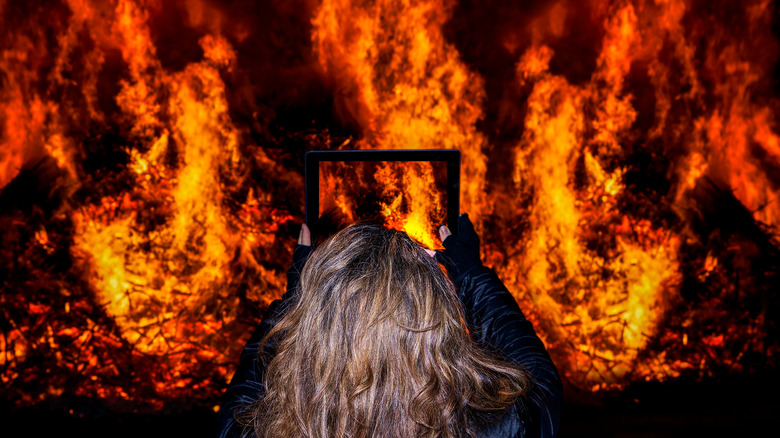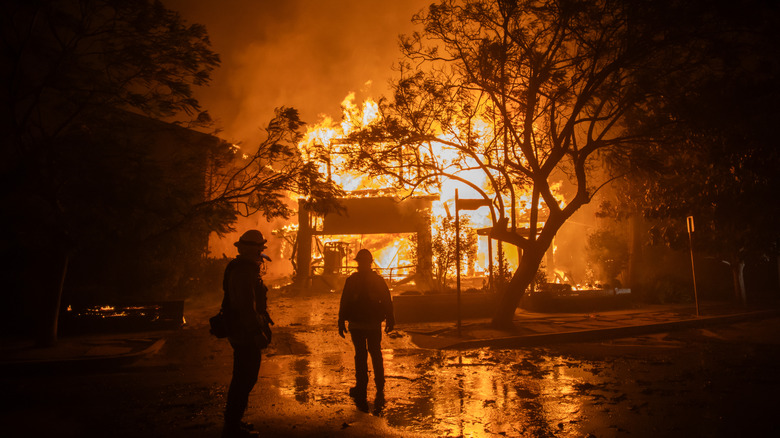An Unusual Type Of Tourist Is Heading To Los Angeles And No One Is Happy About It
As towering flames tore through Los Angeles and entire neighborhoods were reduced to smoke and ash, U.K. royalty Prince Harry and Meghan Markle received harsh words for their presence in Southern California: They were labeled "disaster tourists." The initial accusation came from celebrity actress Justine Bateman, who saw their fateful visit as unnecessary and counter-productive, and many others echoed her resentment. Prince Harry and Markle had been recorded in Pasadena meeting with wildfire victims and thanking a variety of responders and emergency services; they also reportedly helped distribute food and supplies near the Pasadena Convention Center. But a tweet on Bateman's X account described the pair as "no better than ambulance chasers."
It's hard to say whether the Duke and Duchess of Sussex helped "buoy the spirits" of grieving residents, as Pasadena mayor Victor M. Gordo described. But the controversy does speak to a disturbing — and even dangerous — phenomenon: disaster tourism. When volcanoes erupt, levies break, or fires light, there's a minority of thrill-seekers who want to see the chaos in person.
In a twisted way, their motivations make sense: disasters are historic moments, inherently dramatic and visually compelling. In the hyper-competitive world of social media, proximity to a natural disaster could mean harnessing vast attention, when millions of people are anguishing over California's plight. After all, field reporters have weathered hurricanes on live TV for decades, offering no more substance than "it's dangerous out here." Meanwhile, what if a disaster tourist raises awareness? Starts a fundraiser? "Buoys spirits?" Aren't these good things?
Disaster tourism makes the disaster worse
In short: No one should go anywhere near a disaster area during a state of emergency, unless they are actual emergency workers or volunteers with an established organization. As the travel writer Leyla Giray Alyanak sagely summarized it: disaster tourism is dangerous, disrespectful, and strains limited resources. An influx of tourists can also make it more difficult for first responders to access locations in crisis and to do their jobs.
It's one thing to experience a natural disaster while you are already on vacation. And LA residents would be forgiven for photographing or filming the chaos in their (literal) backyards. But it's completely different to see online reports of devastating wildfires, get inspired, book a cheap flight, and think, "That'll make some awesome drone footage."
What happens later is subject for debate. Many disaster-wracked communities — such as New Orleans, Puerto Rico, and eastern Australia — were tourism hotspots before the devastating descent of Hurricane Katrina, Hurricane Maria, and the Australian bushfires. After a period of emergency, mourning, damage assessment, and reconstruction, all these places eventually re-instituted traditional tourism, as their economies rely on visitors. How long this takes depends on the damage caused, and how safe and ready the community feels. You can't rush these things, especially when residents spend months without proper housing or basic utilities.
The people of Los Angeles have received an unspeakable blow, and the city's first priority is to help victims and minimize future damage. The city will survive this, and it will rebuild. Until then, travelers should give the City of Angels a wide berth. No selfie is worth the price.

